“God must love crazy people,” Masoud, the Afghani Mujahideen freedom fighter goads Sylvester Stallone’s John Rambo, “…because He makes so many of them.” If the Internet has shown us anything, it’s that there are far more crazy people out there than many of us would have expected. And in the case of high performance machines – from supercars to personal watercraft – there is no shortage of crazies who only want the absolute fastest machine they can get their hands on. And chances are, you’re one of them. And this review of the 2016 Sea-Doo RXP-X 300 is for YOU and why you are probably not the right person for the RXP-X 300.
So when we were first introduced to the most powerful machine ever built by Sea-Doo, we were understandably excited and equally cautious. Well, most of us that is. There’s a lot to be said for someone being able to master this level of performance. (Undoubtedly, we’ve seen our fair share of pictures of crashed Ferraris and totaled superbikes.) Step One in operating a machine of this caliber is respect. If you think you can just jump right on and let ‘er rip, you might want to think again.
Thankfully, many of us allowed to test ride the RXP-X 300 had no such misconceptions. In fact, you could say that it was more towards the opposite. As we could observe, only a handful were truly willing to push the new 300-horsepower Sea-Doos to their engineered limits, and for more than a single day at that.
And as it is our job to present a comprehensive, true hands-on review of the RXP-X 300 (with the RXT-X 300 to follow shortly), all of us at The Watercraft Journal want you to know that we truly beat on this machine as far as Sea-Doo would let us. This is no “general feel” review culled from after a few sparse minutes of moderate weaving and brief blips of the throttle, but hours of full-throttle flogging. Why? Because if it doesn’t scare you, you’re not going fast enough.
Now, there’s two kinds of scary: scary out-of-control, and scary beyond-your-ability. The RXP-X 300 is clearly the latter. In fact, the level of control imbued in this machine far surpasses anything – and we mean that with exaggerated emphasis – on the market today. Improvements made to the 2016 RXP-X are primarily internal, as its current external form is all but flawless for its purpose; and the RXP-X was built for a specific purpose: cutting a corner with X-Acto knife-like precision.
First introduced in 2012, the current T3-hulled RXP-X is a creation of years of competitive honing, refining and polishing. Riding on a tall center keel that enhances lean-ins and executes neck-snapping corners, the RXP-X’s multistage design features very pronounced chines aft and and progressively softer chines forward. Three-way adjustable sponsons feature canted winglets that only add to the RXP-X’s ability to dip in and carve with indignant prejudice.
The total effect is akin to an aquatic sportbike, doggedly egging to lean hard and snap a hairpin turn, its rolled outer edges literally creating a surface-tension-borne vacuum suctioning the RXP-X’s rail to the water. This machine is not interested in slow, meandering cruises through the mangroves and will, in fact, actually rebel against lazy sweeps, bucking and twitching when ridden by a Sunday driver. The absence of Cruise Control should convey this message enough.
Appropriately first to receive Sea-Doo’s now across-the-S3 line Ergolock seat, the RXP-X prompts the posture of an aforementioned street bike, its foot wedges angling the rider’s knees inward, pinching the padded saddle. The narrow bench eases tension on the driver’s hips, allowing for a more aggressive, forward-leaning posture. The forward stance that the RXP-X 300 requires for maximum performance is contrary to the slacked “Easy Rider” cruising position we’ve seen so many RXP-X 260 owners take, so make note.
Bringing the rider’s chest and shoulders forward not only improves the craft’s weight distribution (and thereby, handling input), but also emphasizes the ergonomic engineering poured into the craft’s fixed-position AES (Adjustable Ergonomic Steering) handlebar. With eight points of adjustment allowing for dozens of configurations (to handlebar grip width and angle), the rider is placed in direct control of a thoroughbred performance craft. New palm wedges molded into the grips provide some ease to the wrists.
As is with all other Sea-Doos, the iControl controls are wisely integrated into the handlebars, allowing the rider to input iTC commands for Touring, Sport and Eco engine tunes, on-demand trim settings via the VTS system, and toggles for the in-dash controls (RPM, MPH, MPG, and fastest lap time counter). A linear boost gauge and digital compass fill out the rest of the LCD screen, flanked by an easy-to-read analog speedometer and tachometer. And with these controls, Sea-Doo continues to lead the industry with the best button feel and response, allowing you to never have to look down to confirm your input was received.
Besides an option of either Lava Red/Satin Black or White/Dayglow Yellow liveries, the outward appearance of the RXP-X 300 remains nearly identical to the previous models. Yet it is worth noting that the RXP-X 300 has packed on some additional weight over its previous iteration (850lbs. dry weight over the outgoing 812lbs.) due in part to the new FMC fiberglass material introduced when the manufacturer moved its full production to Mexico. The added weight is actually a boon to the RXP-X’s ability to cleave through chop and remain planted. Constant pump engagement is imperative to a craft of this magnitude, and the slight weight gain is principally a positive.
Below the transom, Sea-Doo’s engineers heavily reworked the already industry-leading iBR (Intelligent Brake & Reverse). Integrating into the pump, tunnel and ride plate, the new iBR rides on a beefier frame saddling the 10-vane stator, multi-diffuser venturi, new 159.5mm prop and larger diameter wear ring. A redesigned three-piece bucket system deploys to slow the RXP-X a staggering 160-feet shorter than conventional non-brake equipped PWC. Gone too is the nose-plowing characteristic to the previous iBR system as well.
But alas, it is what lies beneath the saddle that is what matters most: As you’ve might’ve already read in our comprehensive unveiling of the complete 2016 Sea-Doo lineup earlier this month, BRP heavily reworked its 10-year-old 1503 4tec Rotax (which remains in all non-300HP 2016 models) into the all-new 1630 ACE 300. The re-engineering resulted in a deceptive package: Externally, much remains seemingly the same – apart from a larger heat sink and redesigned supercharger (more on that in a minute). Internally, the new 1630.5cc features the same 100mm bore but an increased 69.2mm stroke (over the previous 63.4mm), providing 9-percent more displacement, and subsequently, 15-percent more power.
The pistons are more robust, but are 20 grams lighter and feature longer, coated skirts, and spin on lighter, shorter connecting rods. Surprisingly, the pistons slide inside of a coated cylinder, not a pressed-in steel sleeve. A new plasma coating (applied via a proprietary thermal spraying process) was exclusively developed by Rotax’s team in Gunskirchen, Austria, to replace the heavy steel sleeves to not only cut engine weight, but to improve surface durability and heat transference and minimize friction. Combined with an additional cooling circuit, a hybrid dry sump oiling system, the aforementioned heat extractor, and a new, larger intercooler that is 2.2-times more efficient with over double the cooling capacity, totals up to 33-percent improved engine cooling.
The dramatically improved centrifugal supercharger produces an impressive 30-percent more boost (18psi) via a more efficient, compact wheel that spins 8-percent faster at 47,000rpm. The new wheel features double the blades of the outgoing design – increased to 32 – and features a revised drive system comprised of 8 steel washers and two composite bearing packs at either end of a near inch-thick shaft. As per Martin Lachance, BRP’s Engineering Director for the new powerhouse, all superchargers are dynamically balanced prior to assembly.
Final improvements to the new ACE (Advanced Combustion Efficiency) engine is in its a single-camshaft valvetrain configuration: The cylinder head has been improved with a new combustion chamber quench, new larger injectors, and new direct-ignition high-intensity coils that produce double the ignition energy for a hotter, cleaner and more efficient burn. The result of all of this is a dramatic increase in throttle response, assaulting acceleration and an ever-ascending torque curve that peaks at a United States Coast Guard-mandated 68mph (we reached a best of 68.6mph at 7,700rpm). As a rule of thumb, it doesn’t matter if the dang thing made 600-horsepower, it’s still going to be capped at 68.
The only gripes we had were minor: we felt that the new hand grips were somewhat limiting for standing upright or riders who move their grip during tight turning; and prolonged reverse (while under throttle) will noticeably submerge the transom of the RXP-X (and all 300HP models we tested). But our biggest concern was not for the ski itself, but the person controlling it. Days’ worth of testing revealed a craft that was not suited for all audiences. Of course, a Suzuki Hayabusa was never meant for general consumption either.
So, if you do think you’re good enough a rider to fully appreciate the potential in the 2016 Sea-Doo RXP-X 300, if you’re committed to riding this ski as it is meant to, then yes. This is RXP-X that you’ve been waiting for. In our view, there has never been a Sea-Doo to better blur the line between showroom stock and a full-tilt racecraft. The new 300HP model supersedes the outgoing 260 by $300, bringing the total to $15,199 MSRP (or an extra $100 per 100-horsepower).
There are plenty of folks who will read this article, watch our video below and start to salivate. Good. We hope so. But according to the law of averages, most of you just aren’t that good of a rider to fully handle what Sea-Doo has produced here. And that’s OK. But we hope that if you’re feeling up to the challenge, you ease into it. Be safe. Be smart. Because what Sea-Doo has built here is a Stinger missile with handlebars, and that’s all that’s need to be said.










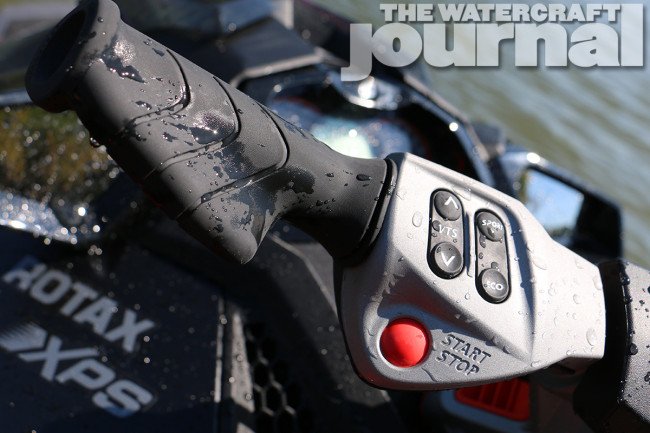
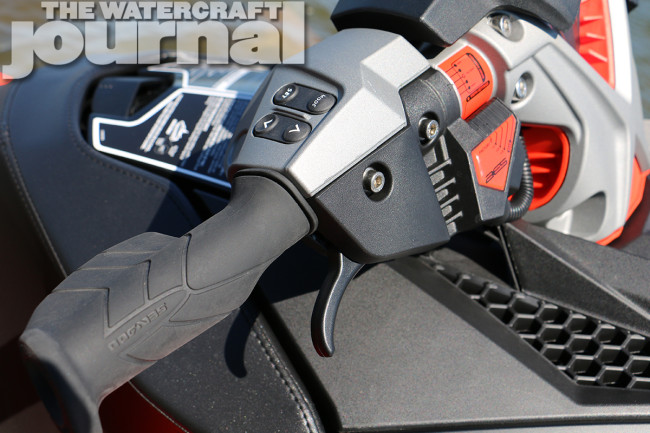




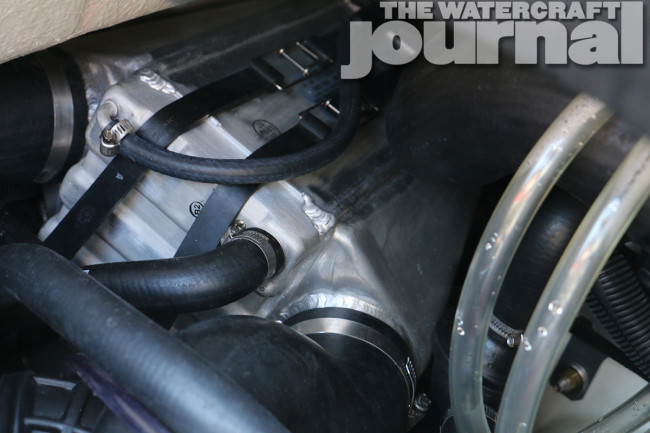


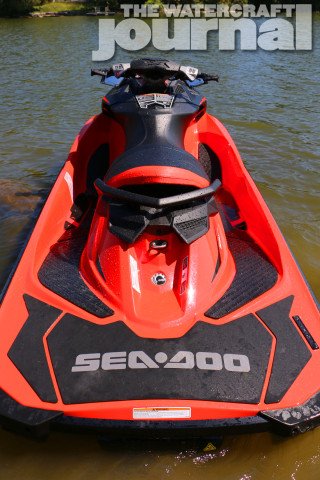

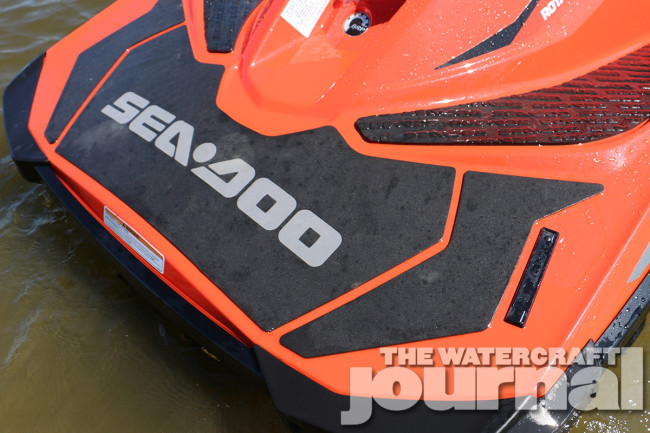
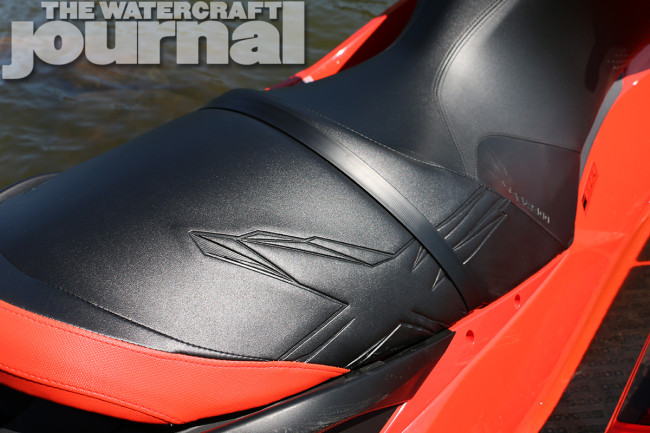




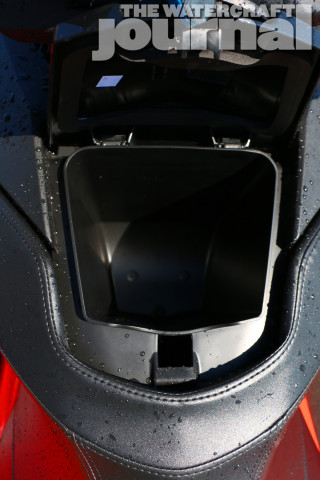



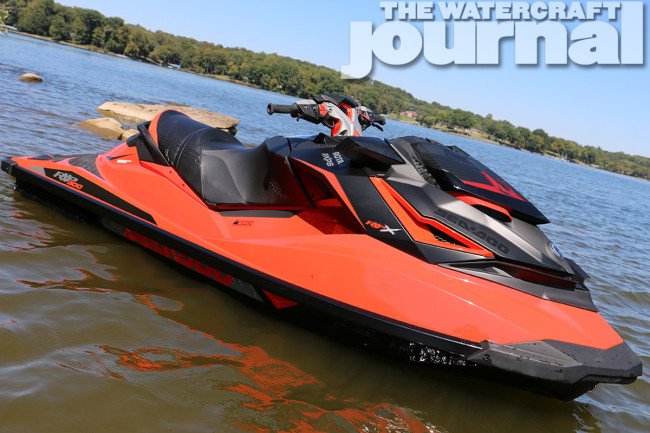





























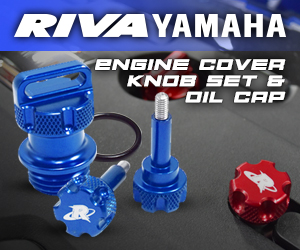





This review spends most of its time talking about how most won’t be “man enough” to handle it. Boring. If you don’t squeeze the finger grip against the handle grip overtime you touch it, I’m sure you’ll be just fine.
that is if you don’t squeeze every time you touch it, you’ll be fine.
Yawn!!! The color is awful.
I would like to see jet ski.What we can see on the video It’s your face only .I will never buy see doo.You right .It’s the best for lakes only so you can swim to the beach because See doo will brake down anytime lol
Yamaha nr1